
edible AUSTIN No. 88 Fall 2023 FALL INTO FALL FALL 2023 | Issue 88




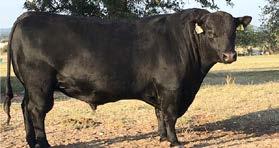


edibleaustin.com 1 CONTENTS 2 FROM THE PUBLISHER 4 WHAT'S ON OUR COUNTER 6 NOTABLE EDIBLES What's Happening Around Austin 12 LOCAL LEGENDS Mozart's Coffee Roasters 16 SPOTLIGHT ON LOCAL What Schools are Cooking 18 EDIBLE ENDEAVOR Ginger Webb's Sacred JourneyPage 22 COOKS AT HOME Fiore Tedesco of L'oca D'Oro 25 EDIBLE ESCAPES Wimberley and the Arts 32 EDIBLE VARIETAL More Mourvèdre, Please 36 FARMER'S DIARY Texas Honey Harvest COVER Nutella Scones (photo by Pauline Stevens) THIS PAGE Fiore Tedesco (photo by Ralph Yznaga) Honey I'm Home Hive (photo by Rodney Bursiel) RECIPES IN THIS ISSUE 28 NUTELLA SCONES 30 AVOCADO WITH SAUTEED MUSHROOMS Fall . 100% Locally Raised and Fed in the Texas Hill Country 100% Black Angus . 100% Locally Processed . NO Antibiotics and NO Added Hormones . Quarters, Halves and Griller Packages Beef for the Serious Beef Eater ORDER TODAY: WindyBarBeef.com 512-474-2855 36 22
As the scorching heat of summer gives way to the crisp and golden aura of autumn, we bring to you another delectable edition of Edible Austin.


In this issue, we traverse the vibrant tapestry of our city's culinary legends as we celebrate the story of Mozart's Coffee, a beacon of Austin's rich cultural heritage. Celebrating 30 years in business, this charming establishment has been more than a coffeehouse; it’s a sanctuary to locals and visitors alike, offering an artisan bakery along with a renowned coffee roasting operation, live music and authentic hospitality, all in an idyllic setting overlooking Lake Austin.
Our Edible Varietal takes us on an expedition through the rolling vineyards of the Texas Hill Country. This season, we explore the nuanced excellence of Texas Mourvèdre wines. Uncorking the robust flavors within a bottle of this wine — created by the rugged terrain and the dedication of local winemakers — reveals an experience that truly embodies the essence of our location and our land.
The enchanting world of Hill Country and Central Texas honey farms beckons us into their wildflower fields and buzzing hives. Our Farmer's Diary story unwraps the tale of these farmers’ passionate commitment to authentic, raw honey. With bees as their companions and the land as their provider, they each remind us of the sweet connection between nature and nourishment.
If you are looking for a recipe that transitions easily from summer to fall, you’ll find our avocado with sauteed mushrooms is a perfect fit for a tasty meal or as a side dish alongside a hearty entree. And for a tasty treat that is great for breakfast or for an afternoon nibble, be sure to try our nutella scone recipe that is sure to be a hit with friends and family.
Thank you for your continued support. Here's to the farmers, artisans, chefs, and you, our readers. May this edition of Edible Austin inspire you to savor every moment, and every bite, of the wonderful fall season.

PUBLISHER/EDITOR
Monique Threadgill monique@atxpublications.com
ASSOCIATE PUBLISHER/ CREATIVE DIRECTOR












Ralph Yznaga ralph@edibleaustin.com
COPY EDITORS
Claire Cella
Stacey Ingram Kaleh
CONTRIBUTING WRITERS
Ashley Brown
Christina Garcia
Stacey Ingram Kaleh
Nathan Mattise
Ava Motes
Yolanda Nagy
Pauline Stevens
CONTRIBUTING PHOTOGRAPHERS
Pauline Stevens
ADVERTISING SALES

Amy Lockhart amy@edibleaustin.com
Grace McCormick grace@atxpublications.com
Stephanie Walsh stephanie@edibleaustin.com

CONTACT
info@edibleaustin.com edibleaustin.com
2 Fall 2023
FROM THE PUBLISHER
5524 Bee Caves Rd., Ste. J-4 Austin, TX 78746 Edible Austin is published by ATX Publications LLC. All rights reserved. No part of this publication may be used without written permission of the publisher. ©2023. Every effort is made to avoid errors, misspellings and omissions. If, however, an error comes to your attention, please accept our apologies and notify us. Edible Austin is a member of Edible Communities. Edible Communities James Beard Foundation's Publication of the Year, 2011 for $35 /year SUBSCRIBE TO THE MAGAZINE AT edibleAUSTIN.com
farmers & ranchers shop sustainably grown food from for locations, vendor lists & more info visit texasfarmersmarket.org saturdays 9a - 1p @ Lakeline sundays 10a - 2p @ Mueller double up to $30 in snap/wic* benefits to spend on fresh fruits & vegetables! *WIC season ends october 30 THE LEANI NG PEAR ill C ountry - i nspired C uisine Unique. Well Crafted . Delicious. 111 W imberley 512-847- pear leaningpear . C om 111 River Road Wimberley TX 512-847-PEAR leaningpear.com Unique. Well-crafted. Delicious. Hill Country-Inspired Cuisine schitzcreek.com thirstymule.com
US: 512-441-3971
local
BY MONIQUE THREADGILL
Nana's Cookies & More Cottage Bakery Items

No fall tableau is complete without a touch of sweetness. Enter Nana's Cookies & More Cottage Bakery, a local treasure trove of confectionery wonders. Nestled in the heart of our community, Nana's Cookies evokes the comfort of homemade treats lovingly prepared by generations past. All of Nana’s baked goods are gluten free and made from scratch with quality ingredients. We sampled many different items — including s’mores cookies, gluten-free banana pudding cupcakes, and vegan and gluten-free oatmeal whoopie cookies — and all were delicious. But our favorite was the brown butter bourbon chocolate chunk cookies. You can find Nana’s Cookies at local farmers markets including Wolf Ranch Farmers Market, Hutto Silo Farmers Market and Liberty Hill Farmers Market, or find more information about Nana’s online.
Facebook @nanascookiesmore
Dos Olivos Tierras de Tavara Premium Olive Oil
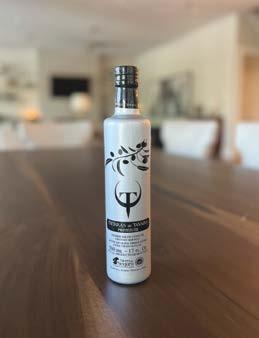
Tierras de Tavara's premium early harvest extra-virgin olive oil is the perfect addition to anyone’s repertoire. This olive oil is made from picual olives, sourced from family estates in Jaén, Spain which are earlyharvested and cold-pressed to preserve their exquisite flavor and health benefits. This premium olive oil is certified organic and boasts a robust, grassy flavor with notes of apple, freshly cut grass, artichoke and tomato. Stop in at a Dos Olivos Market to pick up a bottle in any of their locations in Wimberley, Dripping Springs, Buda and Harlingen, or order online.
dosolivosmarkets.com


Your Go-To For Kids’
Cooking Classes

3-hour cooking classes developed to teach practical life skills and food literacy.
Opening fall 2023
Arbor Walk
Fall enrollment begins in October
Zwita Zucchini and Potato Shakshuka
From Tunisian-Texan brothers, Mansour and Karim Arem, comes a delicious, quick and easy meal in the form of Zwita’s shakshuka. This ready-to-eat shakshuka is made by slow-cooking a carefully selected mix of zucchini, potatoes, onions, peppers and tomatoes in extra-virgin olive oil, their very own traditional harissa paste and smoked paprika. Zwita’s shakshukas come in several flavors, but our favorite was the Zucchini and Potato Shakshuka with melt-in-yourmouth veggies, caramelized notes, complex aromatics and smoky undertones. Simply pour into a pan, crack some eggs and let the fire do the magic for you! Or skip the eggs and enjoy with any protein of your choice.
zwitafoods.com

edibleaustin.com 5 4 Fall 2023
WORDS AND
WHAT'S ON OUR COUNTER
PHOTOS
Monique Threadgill is publisher of Edible Austin and loves to travel and explore new places, foods and cultures. She also enjoys discovering and sharing new products with Edible Austin readers.
ELEMENTARY GOES FROM POP UP TO PERMANENT HOME
Now that school is back in session, so is Elementary — a former Austin pop-up restaurant that has now found its permanent home in the Zilker neighborhood. True to its name, Elementary offers a playful twist on classic dishes, blending seemingly disparate cuisines to create new favorites like al pastor tortellini, snapper with kimchi puree, and banh mi eclairs. Their drink menu is equally whimsical, featuring signature cocktails like a Kool-Aid cosmo with fermented Kool-Aid.
Elementary first got its start with a Sunday Service pop-up at Aviary Wine & Kitchen in November 2022. After distinguishing itself with a blend of youthful nostalgia and forward-thinking culinary invention, Elementary’s new table-service spot continues encouraging guests to have fun with dinner. Though their menu is undoubtedly elevated and experimental, Elementary’s brightly colored, bauhaus-inspired interior cultivates an intentionally casual atmosphere. And, this space will also help make way for all things fresh in the Austin dining scene, with Elementary pledging to share their kitchen with future pop-ups.
Visit Elementary at 2026 S. Lamar Blvd. or online at elementaryatx.com.
MENCHACA BAR SCENE ADDS BODHI’S HIDEAWAY
Fresh on Menchaca’s bar scene is a nostalgic ‘90s oasis: Bodhi’s Hideaway. Point Break fans may spot the reference to Patrick Swayze’s iconic character Bodhi, whose likeness appears in the logo, but the bar’s name also pays homage to the Buddhist state of enlightenment, which co-owner David Pearce hopes to provide at this spot off the beaten path. With a full menu of frozen drinks, creative Point Break-themed shots and tropical cocktails — like the Bodhi margarita with campo bravo reposado tequila, house blend triple sec, blood orange juice, lime, agave and tajin — as well as their selection of draft and bottled beer, Bodhi’s promises a laid-back and beachy escape from the Texas heat.
MORNINGLORY DEBUTS INVENTIVE BRUNCH IN LAKEWAY
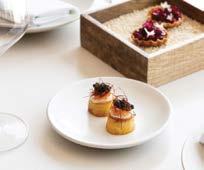
Rise and shine with inventive brunch fare from Lakeway’s latest, Morninglory. Doubling as a restaurant and “seriously good” coffee shop, Morninglory offers a variety of breakfast essentials and midday pick-me-ups made with locally sourced ingredients in a brightly lit, modern space.
The star of the show at Morninglory is the “BLATTS,” a savory spin on the classic BLT, which subs lemon arugula for lettuce and adds avocado as well as sriracha aioli on Texas Toast. They also offer dulce de leche
to the more common Maki rolls, which are typically cut into smaller pieces. Yuki offers a variety of handroll fillings, including lobster, scallops and yellowtail as well as vegetablebased options. They also have nigiri and sashimi, clam miso soup and seaweed salad.
PLANT-BASED RESTAURANT FABRIK OPENS IN EAST AUSTIN
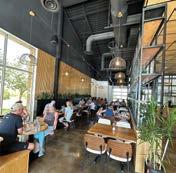
Serving up a conscious take on finedining is Fabrik, a new plant-based restaurant in East Austin. With an omakase-style tasting menu and locally sourced ingredients, Fabrik crafts an intimate and conscious dining experience in their unique “micro restaurant,” which has only 16 seats available. Offering both a six-course and a nine-course menu, Fabrik draws inspiration from a variety of Japanese, Italian and Nordic cuisines. They specialize in creative seasonal dishes like sourdough focaccia with shiitake butter; grilled tofu with tempura shiso, black garlic and ginger kumquat; hand-shaped parsnip cappelletti, and cashew cheesecake.
Fabrik is the brainchild of chef Je Wheeler, who is passionate about promoting sustainable dining. Almost everything on their menu is house-made, and the restaurant aims to use every piece of food to reduce waste.
Fabrik operates at 1701 East Martin Luther King Jr. Boulevard, Suite 102. To book your seat at Fabrik, visit fabrikatx.com.
From the street, Bodhi’s looks like a fixture from an early ‘90s beach flick with their neon-lit surfboard sign and brightly colored patio chairs. Inside, they have TVs to watch live sports and offer weekly promotions like Tequila Tuesday with $2 off all tequila. They have also partnered with
french toast with candied pecans and cinnamon, acai bowls, breakfast panna cotta, and a variety of salads. This can be paired with fresh squeezed juice, drip coffee and classic espresso drinks, or their more adventurous turmeric and beet lattes. And for the adults, they’ve got mimosas and beer from Frontyard Brewing.
Whether you plan to stop and stay a while, or you just want a coffee to-go, you can now visit Morninglory for walk-in service at 2121 Lohmans Crossing Road in Lakeway. To learn more, visit morninglorytx.com.
JAPANESE YUKI HANDROLL BAR OPENS IN WESTLAKE


Yuki is run by co-owners and co-executive chefs Jun Kim and Hyo Lim, whose experience collectively spans from New York to Miami, alongside now-co-owner and CEO John Kim, known for running the former Sixth Street sake bomb spot Sake Mama. The restaurant takes its cues from mom-and-pop handroll shops in Japan, with a fast-casual service style and prices that won’t break the bank (most individual rolls are in the range of $5 to $10).
Visit at 6317-3 FM2244, Suite 330. For the full menu and more information, visit yukihandroll.com.
ARTIPASTA OPENS BRICK-AND-MORTAR LOCATION IN HIGHLAND


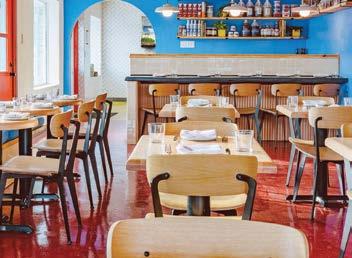
After serving up delicious, house-made pasta and Italian food at their lauded South Austin food truck, Artipasta has ventured north with a brick-and-mortar location in the Highland neighborhood. Artipasta’s co-owners Ugo and Annamaria Bigi opened the original truck on South First in 2018, inspired by the flavors and recipes of their hometown in Mantova, Italy. Though the truck remains open as usual, the new permanent location will allow the Bigis to share their signature pastas and sauces with a greater share of dine-in customers.
Achiote ATX, a food truck behind South Austin Beer Garden (another project from Pearce and fellow co-owner Ryan Thomas) to deliver bites for Bodhi’s customers including tortas, quesadillas and birria tacos. Bodhi's is now open at 10402 Menchaca Rd. To learn more, visit bodhishideaway.com.
Bringing the authentic Japanese handroll experience to Austin is Yuki Handroll Bar, which is now open in Westlake. As the name suggests, Yuki specializes in handrolls, or temaki, a cone-shaped, palm-sized alternative
The new location borrows elements from the original truck, offering Italian comfort food like gnocchi in tomato sauce, spinachricotta ravioli, cacio e pepe, lasagna and more. And, of course, any meal at Artipasta would be incomplete without trying one of their desserts — including cannolis, tiramisu and panna cotta.
Visit at 6406 North I-35 Frontage Road, Suite 2510, within the Linc retail space. or online at artipasta.com.
edibleaustin.com 7 6 Fall 2023
Left: Morninglory owners by Monique Threadgill
Top Center: Morninglory by Matt Tracey
Top Right: Photo by Yuki Handroll Bar
Right Middle: Photo by Artipasta
Bottom: Photo by Yuke Handroll Bar
Top Left: Elementary by Chad Wadsworth
NOTABLE EDIBLES WORDS BY AVA MOTES
Bottom Right: Photo by Fabrik
SEAFOOD RESTAURANT BILL’S OYSTER OPENS IN DOWNTOWN AUSTIN


Serving up mixed drinks and coastal favorites in downtown Austin is Bill’s Oyster, a new cocktail bar and specialty seafood restaurant. Bill’s was founded by Stewart Jarmon and chef Daniel Berg, two friends seeking to cultivate a gathering place where locals can enjoy the highest quality oysters and seafood towers while sipping on craft drinks.
Bill’s is already making waves with its raw bar, which offers East and Gulf coast oysters, crab cocktail, yellowfin tuna tartare, sea urchin, littleneck clams and much more. They also have two seafood towers: the Lavaca with oysters, shrimp, clams, lump crab, tuna tartare and king crab; as well as the Colorado with oysters, shrimp, lump crabs and clams. But their menu doesn’t stop there — they also have a variety of dinner plates like jumbo lump crab cake with remoulade and grilled lemon; a large lobster roll with tarragon aioli and fries, and caviar mozzarella sticks. Though their cocktail menu offers many classics, they also have unique twists on the martini and negroni, all served up in a New Orleansinspired space
To try Bill’s, visit them at 205 W. 3rd Street or online at billsoyster.com.

Their fast-casual location at Fareground on Congress is remaining open, while the new truck will cater to concert goers and Parisian food fanatics alike. Having grown up in France, Sophie hopes to give Austinites a taste of her favorite hometown staples. This includes menu items like whole birds, half birds or quarter birds with potatoes cooked in chicken drippings; the Roti Bowl, which is an arugula salad with shredded rotisserie chicken; the Poulet Roti Baguette, which serves up the house roti sandwich-style, and many more French soups and salads.
The new Austin Rotisserie food truck is located at 8504 S. Congress Avenue. For more information, visit austinrotisserie.com
AUSTIN ROTISSERIE REOPENS FOOD TRUCK AT FAR OUT LOUNGE
Whether you come to the Far Out Lounge for the food or the tunes, you’ll sing the praises of both — especially now that beloved French comfort food spot Austin Rotisserie has re-opened their food truck at the South Austin venue.
“We are excited to bring our food truck back, complete with a fresh coat of pink paint,” says Eric Nathal, who co-owns Austin Rotisserie with his wife Sophie. “We have some amazing customers in South Austin so we are looking forward to seeing them at The Far Out on a more permanent basis.”

Per the name, Austin Rotisserie’s menu centers around rotisserie chicken — priding itself on being the only restaurant in Austin cooking on a traditional French rotisserie.

EDIBLE WRITER RELEASES A TAIL OF GRACE

While we are on the subject of animals, we wanted to share a new book from our Edible writer, Ashley Brown. In her newly released book, A Tail of Grace, Brown eloquently captures the heartbreak that anyone who has suffered the loss of a cherished pet (or person) will relate to deeply. To read more about it or purchase a copy, visit ashleyauthor.com
JUST A REMINDER: WE SERVE FROZEN DRINKS.

8 Fall 2023
Top Left:
Photo by Bill's Oyster House
Bottom:
Photo by Bill's Oyster House
Top Middle:
Photo by Austin Rotisserie
DESERT DOOR DISTILLERY & TASTING ROOM 211 Darden Hill Rd, Driftwood, TX 78619 Thursday Friday Saturday Sunday 12 – 8 PM 12 – 9 PM 11:30 AM – 9 PM 12 – 6 PM Closed Monday - Wednesday ALL RIGHTS RESERVED ™ AND COPYRIGHT © 2023 DESERT DOOR
Right: Eric Nathal photo by Austin Rotisserie Ava Motes is an Austin native who follows the city's expanding food scene with an eye for the people and stories behind beloved menus. In her spare time, she loves trying new restaurants, exploring farmers markets, and relaxing in cafes with a good book in hand.






edibleaustin.com 11 10 Fall 2023 it’s all in the details Find an agent & request a quote at societyinsurance.com/Texas . TRIED-AND-TRUE RESTAURANT & BAR COVERAGE WITH NO SURPRISES. SMALL DETAILS. BIG DIFFERENCE. Long-standing industry expertise means that nobody understands the unique challenges of protecting your hospitality business better than Society Insurance. Offering tried-and-true specialized programs for every type of restaurant and bar establishment, we are proud to provide our comprehensive coverage to the Lone Star State. T HE LONE S TAR STAT E N OW S E R VIN G Warm and Friendly Neighborhood Restaurant Happy Hour Indoor and Outdoor Dining Private Parking Lot Open Seven Days a Week Weekend Brunch 1417 South 1st St. Austin, TX 78704 512-551-2430 1417frenchbistro.com info@1417atx.com
MOZART'S COFFEE ROASTERS
AUSTIN'S OG COFFEE HOUSE CELEBRATES 30 YEARS OF AUTHENTIC HOSPITALITY AND COMMITMENT TO COMMUNITY


 WORDS BY STACEY INGRAM KALEH | PHOTOS BY MOZART'S COFFEE ROASTERS
WORDS BY STACEY INGRAM KALEH | PHOTOS BY MOZART'S COFFEE ROASTERS
In the Local Legends series, we shine the spotlight on a restaurant that’s been serving the community for more than three decades. These iconic spots have become part of the fabric of our shared culture, with multiple generations of Central Texans able to fondly reflect upon memories made at these beloved eateries. In a rapidly growing and changing region, they’ve stood the test of time. Yet, they still need our support so that they can be enjoyed by future generations. It’s time to rediscover the restaurants that keep our communities authentic, vibrant and resilient.
Multi-level decks stretch out along the edge of Lake Austin’s sparkling blue water, dotted with picnic tables and under the gracious cover of heritage oaks. Hand-painted signs greet visitors and welcome them into an oasis filled with the aroma of freshly brewed coffee and baked goods and made even sweeter by the sounds of live music, birds and community in fellowship.

It's hard to think back to a time before coffee shops were just around the corner, a staple of our neighborhoods and urban environment. Before national chains expanded to Austin and before the local roasting scene grew to national acclaim, Mozart’s Coffee Roasters brought a unique vision to our community. “The original tenets of the business are still our tenets today, which are really three things in probably the following order: Bakery, Coffee, Place,” says Ken Leonard, owner/operator, co-founder and CEO. “We had this idea of fresh-roasted coffee on the premise, which didn’t exist in Austin. At the time, there was really only a local roaster — Anderson’s — which was here years before us. But Anderson’s wasn’t a coffee shop, it was a coffee roasting company,” Leonard shares. “We’ve been roasting and baking onsite since day one, and that’s never changed. It’s just gotten bigger and bigger and bigger.”
Founded in 1993 by four local couples with a passion for quality coffee and inspired by the specialty coffee scenes emerging in southern California and Seattle, Mozart’s is celebrating its 30th anniversary this year. From its start as a small stone building on a grassy knoll to a sprawling, multi-level and multi-building lakeside retreat, Mozart’s has grown with Austin. It continues to expand its offerings today, is consistently responsive to its customers and has innovated and evolved over time.
When I visited with Leonard during the summer, Mozart’s was building a brand new state-of-the-art coffee roaster to celebrate Director of Coffee Jack Ranstrom’s 20th anniversary with the company. They had also just opened an indoor loft area with a stage for live jazz, were installing an automated wheelchair lift and were about to open a paddleboard launch station called “Lake Austin Calm.” There was an air of excitement as we walked up and down through the cafe building, the decks, “the Loft,” “the Grotto,” the gift shop and the many idiosyncratic vignettes that comprise the property. Leonard greeted employees like friends, and nothing felt decades old or settled. The best way I can think of to describe Mozart’s is alive — growing, changing and filled with energy, a lot like Austin itself.
When it came to the coffee, Mozart’s wanted visitors to see the coffee being roasted in front of them. Mozart’s coffee uses fair trade, ecologically sourced “green beans” and is crafted by expert Ranstrom.“We recruited Jack [Ranstrom] and moved him here from Seattle. That was 20 years ago, where the roasting scene was exploding at the time.
Jack was one of the first apprentice roasters for a very successful company called Seattle’s Best, which was later acquired by Starbucks and still to this day remains their wholesale outlet … so Jack was part of that group that birthed the Seattle coffee scene.” Leonard shares that when they first brought Ranstrom on board, Mozart’s could not afford a coffee specialist, so he and his wife Stacey mentored Ranstrom to oversee the entire coffee shop’s operations. Now, as Mozart’s roasting business has grown, Ranstrom is able once again to specialize and focus on the coffee.
Alongside a commitment to specialization, dedication to service has been key to Mozart’s growth and resilience over the past 30 years and has helped them create a distinct sense of place, their third tenet. Mozart’s is one-of-a-kind, and has invested in its original location rather than expanding elsewhere. “We’ve sort of remained this hometown holdout,” Leonard says. This investment and commitment to community seems to have paid off, too. “We never could have imagined what’s happened systematically over 30 years to the business. The business today will do more in a busy hour than it did originally in a week,” Leonard shares.
Leonard tells me the four couples who co-founded Mozart’s had a collective background in hospitality. “We’re always asking, ‘How can we make it possible for our customers to have the best experience they can have?’ And that has tons of inherent challenges … and it takes a lot of dedication, effort, planning and organization,” says Leonard. Mozart’s team members are crucial to crafting a great customer experience, where authentic hospitality allows everyone to feel comfortable. Leonard emphasizes “...it also takes the right people who want to be in a business that’s primary goal is to serve other people, genuinely serving people and genuinely making other people happy…” Accessibility is also a cornerstone for Leonard and Mozart’s, and an important part of its place-making. “It’s really pretty simple: everyone is welcome here,” he says. “We want to be open and accessible to as many people as possible with respect to the quality of our craft when it comes to baking, making, roasting and performing.”
Leonard, a University of Texas at Austin alumnus, attributes much of Mozart’s early success to its proximity to UT Austin’s labs and married student housing on Lake Austin (Mozart’s and the other residents of Oyster Landing reside on university property). Diverse groups of university students embraced the local spot for caffeine and baked goods. “Mozart’s has been given access to people from all walks of life, all different proclivities, all different interests, all different identities and that fabric has really, almost automatically never been anything that we had to try to contrive or engineer… That community sort of started instantaneously, and we were the benefactors. I think that got other people feeling comfortable that Mozart’s is a place that is welcoming to everyone.” According to Leonard, these days Mozart’s welcomes about one million visitors each year.
It becomes clear in speaking with Leonard that serving their community requires a lot of helping hands. From dedicated longtime employees who are the heart and soul of the operations to loyal partners, contractors and vendors who help maintain the building and grounds throughout Texas’ extreme weather conditions, it “takes a large cast of characters,” as he would say, to maintain a place like Mozart’s.
Live music could almost be called a fourth tenet of Mozart’s philosophy. “We’ve also done music since day one … and we take a lot of pride that we’ve never deviated from that.” Leonard emphasizes how much the local music scene has changed in the past 30 years and the increasing challenges for musicians, including cost of living, which only further fuel his passion for supporting local artists.
From its inception, Mozart’s has been more than a typical coffee shop, open every day from 7 a.m. to midnight and showcasing the work of Austin’s creatives — from musicians and singers to comedians, visual artists, dancers and makers of all kinds. Since Mozart’s team is itself comprised of makers, bakers, roasters, artists and entertainment coordinators, they have a unique opportunity to collaborate on the design of thoughtful events. For example, event themes often carry through from the music lineup to the bakery and drink menu (expect holiday-themed treats during the winter light show, and German-style pretzels during Oktoberfest performances). Some of Mozart’s events are now inextricably tied to its identity, such as their annual Christmas Lights Show, now in its 13th year, and their weekly “Late at the Lake” open mic nights. Leonard takes pride in these intentional collaborations that create the Mozart’s experience, saying he feels a combination of luck and being blessed.
Undeniably, part of the appeal of Mozart’s is that it grants us the illusion that we are floating on the lake. (The first time I took my 4-year old daughter, she asked if we were at a boat house!). It has created a welcoming gathering spot on some of the city’s prime real estate, allowing us to feel like we almost “co-own” this heavenly little piece of Lake Austin. For some runners and kayakers, it’s a morning ritual. For some college students, an evening study spot. For those who make their own schedules, it’s a place for business meetings. For families like my own, Mozart’s offers a shady and joy-filled haven where the parents can grab some much-needed caffeine while giving the kiddos a sweet treat.
edibleaustin.com 13 12 Fall 2023
LOCAL LEGENDS
Left: Live Music
Right: Some of the many choices
Left: Stacey and Ken Leonard
Right: The famous deck
“What keeps us focused on continuing to innovate and grow is that we genuinely believe we’ve been given a gift here.” Leonard says. “We have a responsibility to the many families that depend on Mozart’s for their livelihood and the many people in the community that depend on Mozart’s for fellowship and gathering and having a sense of place that is an important part of their lives. Keeping that relevant and sustainable and successful is an important objective. It’s an everyday objective here.”
Whether you enjoy a quiet early morning cappuccino watching the ducks and turtles, or a sunny afternoon cold brew under the cover of sprawling heritage oaks, you can find it here. And you can anticipate running into old friends, new friends, colleagues and acquaintances, because Mozart’s is truly a town square. “I’m looking forward to Mozart’s remaining relevant,” says Leonard. “I’m looking forward to Mozart’s continuing to reflect the genuine inclusiveness that the Austin, Texas community is.”
ORDER UP

First, choose your brew. From a refreshing and smooth cold draft latte to an impeccable classic cappuccino or bottomless drip coffee spanning light to dark roasts, there are plenty of options for coffee lovers.
In the mood for something savory? Go for one of four quiche varieties including gluten-free options like potato leek and sausage potato, or try the spinach feta or chicken and green chili empanadas. Refueling after a morning run or paddleboarding session? Opt for cranberry walnut oatmeal or Greek yogurt with fresh berries and toasted almonds.

Looking for a sweet treat or evening pick-me-up? Try one of Mozart’s long-time favorites, such as the Texas pecan coffee cake with cinnamon sugar streusel, vegan chocolate chip cookies or a slice of their legendary Espresso d’Oro Opera Cake layered with chocolate ganache and espresso buttercream, which incorporates coffee specifically formulated for this delicious dessert.
ACTIVITIES & EVENTS



Mozart’s is host to a wide variety of live music almost every day. Enjoy a refreshing paddleboard session in the “no-wake zone” with Lake Austin Calm. As of this summer, you can now paddleboard up for breakfast or a snack and Mozart’s will store your board, or rent a board and paddle out from their launch area after your morning brew.
Stop by the Mozart’s gift shop to find local gifts for the caffeine lovers in your life. Browse t-shirts, mugs and a wide selection of in-house roasted coffee beans.


Mozart’s hosts “Late at the Lake” open mic nights on Tuesdays from 8–11 p.m. Dozens of singer-songwriters, poets, comedians and professional musicians make their way to the stage to share their talents.

During the holidays, don’t miss the Mozart’s Christmas Light Show — a bonafide Austin tradition! Local light artist Katrine Formby works on the design and construction of a new, custom show each year. See the decks and trees filled with dazzling LEDs and grab holiday-themed coffee, cocoa, cookies and more.
Stacey
edibleaustin.com 15 14 Fall 2023
Left Top: The famous facade
Left Bottom: Bakery finds
Right Top: Repurposed cups
Enjoy a grand TEXAS time ! in Fredericksburg, Texas!
October 28 • Noon-7pm • 22 Texas wineries • Specialty booths • Prize pull and auction • Toe-tapping music • Food concessionaires • Texas craft beer • Gargantuan grape toss Downtown Market Square (Marktplatz) Plus three special events: • Oct. 26 Messina Hof
Oct. 27 - Becker Vineyards
Oct. 28 - Marktplatz Patron Brunch GET Locally grown, raised, and produced foods from all over Texas delivered straight to your door. • ENTER “1STBOX” for $10 OFF YOUR FIRST ORDER • DELIVERY AND PICK UP OPTIONS AVAILABLE Cook with the same ingredients as the best chefs in Texas. place your order at
Ingram Kaleh is a native Texan and writer and editor for Edible publications When she’s not eating at local restaurants and drinking Texas wine, she’s spending time outdoors in the Hill Country with her husband and two young daughters and soaking up as much live music and art as possible.
Saturday,
•
•
FOOD FOR THOUGHT
WORDS BY NATHAN MATTISE
Given all the diverse and exciting things happening in Austin dining these days, maybe it’s no surprise the same can be said for food initiatives across local schools in 2023, too.



Kealing Middle School in East Austin has had a successful traditional culinary arts program for a while now, notably

“The kids are fully in charge of what they present, you just kind of guide them — think about this, think about that. ‘OK, you’re going to smoke it? What temperature?’” says Adriana. “Some day, some of these kids will get recruited. ‘You want to come to Navarro? You had the most amazing BBQ, and we really enjoyed your technique and enthusiasm.’”
Developing new culinary skills isn't the only exciting food initiative happening in Austin schools, though. Across Lake Travis ISD, for instance, students get a unique focus on nutrition through the lens of local produce. By leveraging some funding from the Dell Foundation, the district has partnered with the Sustainable Food Center to identify nearby farmers and regularly bring different fresh, local products into cafeteria offerings — like Greener Pastures Chicken from Elgin or True Harvest Farms and their hydroponic greens in Belton. The goal, says Lake Travis dietician and marketing coordinator Marissa Bell, is to try and bring in a new featured menu item each month and then build some educational programming around it.
winning AISD’s annual Sliced & Diced recipe development competition in 2022. That led to a Kealing student-created burrito appearing on menus across the district. But last year’s new program director and chef, Gloria Adriana, has built upon that interest with even more challenging culinary initiatives for her middle schoolers. They run a small catering operation that worked parent-teacher night last year and will handle two student art shows in the 2023–2024 school year. Their most ambitious upcoming project might be the one that calls for some occasional days to start at 6 a.m.
“Last year, my kids officially started practicing so we can formally start the BBQ team this year,” says Adriana. “My students have done pork chops, they’ve done waffles and chicken, they’ve done BBQ, grilled corn — all this amazing stuff. And they learned a whirlwind of things.”
This academic year, a team of Kealing students will become one of the few middle schools in the state to compete in the Texas High School BBQ competitions. Last year’s championships in Round Rock involved 90-plus teams competing after they each qualified by finishing in the top 10 of 11 different regional competitions. The prepared meals must break down across five judged categories — chicken, brisket, ribs, beans and dessert — and students take the lead on every detail, from starting the fire to picking the seasonings.
One big example was Lake Travis’ 2023 Earth Day meal. Since Greener Pastures serves a number of restaurants around Austin, Bell and the team were able to connect with chefs Iliana De la Vega and Ana Torrealba of El Naranjo. The chefs planned and prepared a special Chicken Tinga Taco meal for students last April using Greener Pastures’ products. Greener Pastures farmers came out to the cafeteria that day as well, so students interacted with both the pros who were raising the ingredients and those who were preparing them.
“I was out on the lunch line serving that day, and we had students coming back for thirds. They were saying it’s the best taco they have ever had, and it was exciting to see because you don’t usually see that enthusiasm about school food from the students,” says Bell. “I even had one girl come up to the lunch line, and she was jumping up and down shrieking, ‘Y’all are serving real food today, I can’t believe it, I’m so excited.’ She called it real food, which I thought was interesting.”
“These kids notice the quality and they value these things,” Bell continues, noting Lake Travis hopes to do events like this once a semester going forward. “It’s a new generation and they care about the impact this is all having on the future, and they care about what they put in their bodies.”
Over at St. Stephen’s Episcopal School, student-led food initiatives focus on inclusivity and sustainability. St. Stephen’s has more than 600 students in grades 6 through 12, with about 170 boarding students from 20 countries. "Food is a universal language, and we grow our community through the exchange and sharing of food. The objective is to give our residential community a small glimpse of their dorm mates' life and cultural experiences,” says Gene Phillips, Jr., director of residential life & 12th grade sponsor. "Students plan the menus, lead the community in prayer in their language, and are allowed to share stories about where they live with the community. Understanding where one is from helps bridge the gap in intercultural communications.”
Working with organizations like the student government or the Green Goblins environmental club, the school has a robust composting program and recently added solar panel arrays. But for 2023, the newest project is a hydroponic garden directly in the cafeteria that can eventually be replicated and scaled up to produce herbs or vegetables for student meals.
“Luckily St. Stephen’s sustainability commitment has been there,” says senior Harrison Oddo, who is designing the garden and has been one of the students working on the school’s recent sustainability initiatives. “So it’s been super fun. It’s a little creativity with some environmentalism and sustainability in mind.”
As he currently works to finalize the design, Oddo hopes the garden will be up and running this school year. The project will ultimately also come with some sort of practical and educational guide — filled with ideas and information for educational programming as well as instructions for additional builds — so “hopefully people will be able to copy and paste this process and design a little bit,” he adds. And if that happens as planned, it will simply be the latest victory in St. Stephen’s students’ step-by-step approach to building a more sustainable campus.
edibleaustin.com 17 16 Fall 2023
SPOTLIGHT ON LOCAL
“It’s a new generation and they care about the impact this is all having on the future, and they care about what they put in their bodies.”
AUSTIN'S PRIMARY SCHOOLS ARE NO LONGER JUST SERVING FOOD, THEY'RE TEACHING IT
Top Left: St. Stephen's Lunar Celebration Bottom Left and Top Right: Greener Pastures at Lake Travis High School
Journalist Nathan Matisse (@nathanmattise) is always working to perfect his sourdough bagels. He also enjoys bocce, amaro, road trips, and a good playlist.
Left: Sliced and Diced at Kealing Middle School courtesy of AISD
Sacred Journey
GINGER WEBB'S WORLD OF HERBAL MEDICINE
 WORDS AND PHOTOS BY CHRISTINA GARCIA
WORDS AND PHOTOS BY CHRISTINA GARCIA
As a self-declared “geek” who rejects pseudoscience around alternative healing, Ginger Webb still asks plants for permission before harvesting them. Though she once worked in AI and has a graduate degree in French linguistics, she’s “as woo-woo as they come,” she says when we met at her home in Wimberley.
Webb owns the Sacred Journey School of Herbal Medicine. She also owns Texas Medicinals, an apothecary she created 24 years ago after her herbal medicine training with the late founder of the Southwest School of Botanical Medicine, Michael Moore.

She’s a gentle presence as she offered me a cup of tea and led me outside to talk, pointing out a hummingbird fluttering gracefully nearby and then telling me how her life would soon change.
“After 24 years of running Texas Medicinals, I'm selling the business,” she says. Someone with vision and energy will expand it. I’m moving back to Austin. I miss my people. I miss being with my people.”
Texas Medicinals makes plant medicine, which Webb often grows and harvests herself before using it in healing work with clients. “A lot of healing happens because you listen to someone talk about their problems. I talk to people for hours,” she says. Connection is crucial, and Webb is generous as she shares her knowledge of field botany and medicine making.
Her elixirs and tinctures give succor to midwives and pregnant people, for example. The tiny bottles of liquid might help alleviate or manage mood, headaches, allergies and breathing difficulty.
She led me into her storage room, where we were surrounded by hundreds of bottles in large and small dark jars labeled for sale and storage. She carefully dripped half a dozen tinctures onto my tongue from small droppers. I didn't try any of the pleasure extracts, but I do remember one elixir that felt fiery, like a drop of water evaporating on a hot pan. The names and uses for the tinctures she shared were like a small master class in herbalism.
The peach leaf extract, the one that burned my tongue, is known to cool emotions, physical heat and irritation. It can also help with hot flashes, irritated digestion and morning sickness. A tincture of Devil’s Club from the Pacific Northwest often makes people cry. Her Vital Stimulant extract is often given to people on their deathbed to help them become more lucid. Cotton root could be an ally to women who need to miscarry or those who wish to have a vaginal birth.
Webb has a few interested buyers for the apothecary, which, once sold, will leave her more time to manage and instruct at the Sacred Journey School. Created shortly after her daughter was born in 2001, the school began as a meeting of five women in Webb’s kitchen for the two hours when her daughter was in school. Last year, around 75 people enrolled in the various courses she offers.
JOIN EDIBLE AUSTIN FOR AN EXQUISITE 5-COURSE DINNER AT 5 SOUL WINERY




THURSDAY, OCT. 12 6-9 PM
"Every student comes to the table knowing how to do at least one thing with herbs: make tea. We grow from there,” she says.
When Webb’s daughter was young, she begged to learn how to “make spells,” and the course called Kitchen Witchery was born. It’s a short introduction to her most popular course, the 200-hour Foundations of Herbalism class.
Beerburg Brewing owner Trevor Nearburg recently went through Webb’s course pipeline. When we spoke over the phone, he said her course transformed his relationship to the outdoors, as well as his family’s and their friends.’

“Ginger’s whole reason for calling her school Sacred Journey is that she feels that for her students, you learn about herbalism and then see what it means to you,” says Nearburg.
Webb says she founded her school to help people feel more connected to the environment, and from her school, small businesses have sprung up as students create their own independent apothecaries like White Deer, Corazon Verde Yerbas and others.
Webb walked me to her garden where she demonstrated listening to plants. How? “Be open to the concept. Feel it in your heart. Plants are alive just like I am alive,” she says.
The pink evening primrose did not want to be picked, she says, but other plants there did.
We tried the cucumber weed. The tall lamb’s quarters are food, she says, pointing out the deep lilac powder they grow like fairy dust. Webb rubbed a bit with her finger and then touched her cheek, describing the natural blush. We harvested fresh estafiate, or white sagebrush, for her students.
“People get about 100 herbs in a goodie box,” she says. Every Tuesday night from September to May, students taste the herbs together as teas. Optional outdoor classes meet one weekend a month in wild places, with students arriving from as far as the Valley, Houston, Dallas, Georgetown and Kerrville.
Outside in the garden before we went inside, she plucked a few more flowers for us to eat, careful not to overharvest.
Learn more about Ginger at gingerwebb.com.

Christina
Indulge in a symphony of tastes expertly crafted by Chef Vesh of Fuse 9 in a picturesque setting. Each course is thoughtfully paired with exquisite wines from 5 Soul Winery. Whether you’re a wine connoisseur or a fine-dining enthusiast, this evening promises to be an unforgettable journey for your palate. Seating is limited. Reserve at edibleaustin.com/events
VERIFIED





Did you know you can help regenerate America’s grasslands while having nutrient-dense pastured products delivered to your door? In fact, for every box you purchase we will seed 100 milkweed plants giving the Monarch Butterfly a fighting chance on their epic migration. The population of these endangered pollinators have been declining for decades but together we can reverse that trend by restoring habitat in their migration corridor.

edibleaustin.com 19 18 Fall 2023
EDIBLE ENDEAVOR
bestfriends.org Adopt from an Austin shelter. EATREP.COM
Garcia writes about music and travel and recently became a published author with the 2022 release of 52 Things to Do in Austin and San Antonio.
REGENERATIVE
healthier meats for a happier planet.
Delivering
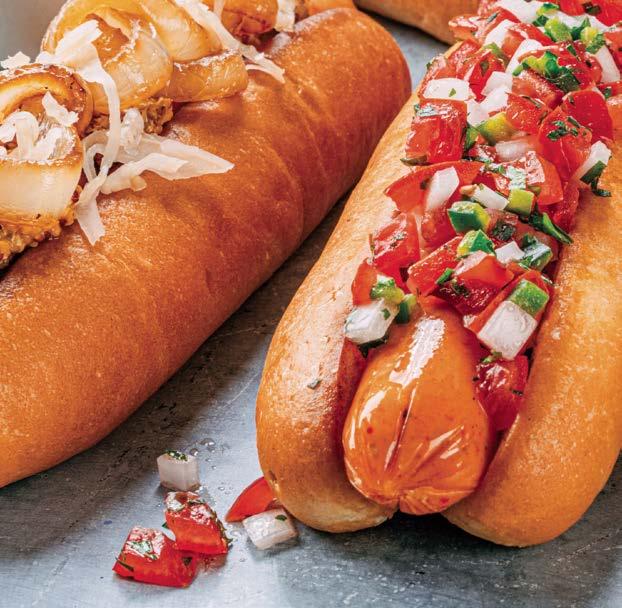





















edibleaustin.com 21 Find Kvarøy’s salmon hot dogs in the frozen section of the fish and seafood department at Whole Foods Market. Findastore nearyou OURSALMONHOTDOGSARE DELICIOUS,HEALTHY,AND SUSTAINABLEINEVERYBITE! Proudsupporterof CanaHOTDOG CHANGEthe World?
Chef's Table
CO-OWNER/CHEF FIORE TEDESCO OF L'OCA D'ORO SHARES HIS HEART IN EVERY DISH
 WORDS BY NATHAN MATTISE | PHOTOS BY RALPH YZNAGA
WORDS BY NATHAN MATTISE | PHOTOS BY RALPH YZNAGA
If you’ve had the polpette — lush pork and brisket meatballs in tomato jam — at beloved Austin institution L’Oca d’Oro, you’ve essentially also tasted chef/co-owner Fiore Tedesco’s most cherished childhood memories. And he has plenty of good ones. Chatting in the chef’s eclectic home kitchen, tidbit after tidbit about his past emerges. Any one of them could be someone else’s most interesting fact about themselves. For instance, Tedesco’s early aughts band (in retrospect, the very appropriately named Feast) used to share a practice space with TV on the Radio and Interpol in New York. He played drums growing up and would’ve attended a music conservatory, but he loved tennis too much. He followed an athletic scholarship to Hofstra instead.
Yet ask Tedesco why he’s in Texas preparing humble Italian food instead of touring Europe with a drumkit or teaching tennis lessons on the Upper East Side, and he doesn’t hesitate. “I grew up in kitchens; I have a background where I have an intimate relationship with the preparation of food,” he begins. “I had quieted any notion of cooking for a living for quite some time, but it honestly came back to me in dreams.”
Tedesco shares how his parents’ difficulties led to a young Fiore growing up in his grandmother’s kitchen as he worked through his own struggles communicating as a non-verbal child. Even though he couldn’t tell his grandmother, he showed affection by mimicking her every move.
“I knew I loved my grandmother’s meatballs more than just about anything, so every Sunday morning I’d be at her hip ready to do whatever she wanted me to do — making pasta, rolling meatballs, anything. I loved doing it, maybe mostly because I’d be rewarded with eating a meatball,” he says. That eventually evolved into roles like making mozzarella at his uncle’s deli
or baking bread at another uncle’s bakery.
“All of those things are kind of the foundations of what we do,” Tedesco says, tying it all to the present day at L’Oca d’Oro, which just celebrated its 7th anniversary. “The way you remember things, it can be hard to trust. We change memories. But in trying to honor the parts that are meaningful to me, I try to amplify those memories by refining the action that was in them. So my meatballs are decidedly different than grandma’s; the mozzarella I make is way better than the stuff I grew up with. But I am partly inspired by the memory of the comfort those things brought me as a kid.”
Despite all the local adoration and accolades his restaurant has received, Tedesco seems to constantly push himself. He’s hustling to open a new “New York meets grandma’s pies” pizza spot called Bambino in East Austin a few minutes south of L’Oca d’Oro (perhaps as early as this
fall). And while the dish he’s preparing today — Ravioli alla Norma, stuffed with roasted eggplant and ricotta salata — currently appears at L'Oca, Tedesco actually developed it for someplace else entirely. He hopes to open what would then be his third restaurant serving “coastal Southern Italian — so a little bit of Italian, a little Portuguese, a little French" at a spot in Crown Heights, Brooklyn, within the next few years.
“The idea I had for the food is: We make these assumptions about the authenticity of these different cuisines and places,” Tedesco says.
“Having just been in Italy and having family live there, the assumptions we make — ‘This is real!’ — comes from a very specific perspective.
That pasta dish is real, it’s traditional, but they’re making it for you, for you the tourist. Then you come back to my restaurant and say, ‘No, make it like that — it’s authentic!’ It becomes a bizarre conversation.”
“So authenticity can also be a fantasy, but we don’t recognize the fantasy we live in,” he continues. “So we should have a sense of humor and not take everything so seriously, and have some fun — let that be the label and don’t get trapped in what’s real and what is not. I won’t write that on the menu, but this is one of the dishes.”
Traditional Pasta alla Norma is a Sicilian dish with fried eggplant, salata, tomato and chile. In this version, “I just reconfigured the parts,” Tedesco says. He uses Japanese eggplant, which tends to be slightly sweeter and more tender since it’s smaller.

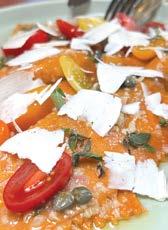
Torn to look like a razor clam, Tedesco pairs that with the ricotta salata (which is dried, aged and salted to lightly mimic some briney-ness) and stuffs a soft, long ravioli. It impressed New Yorkbased restaurant investors, and the chef quips that even his 18-month-old will try it.

If you’ve ever tried a pasta club kit from L’Oca d’Oro, watching Tedesco create his pasta at home feels like finally reading the book Hollywood based your favorite movie on. He promptly pulls the almost burnt-orange ravioli from the water to keep it just al dente. Then he finishes it for a few moments in the pan the next burner over, where he’s been browning a few other pre-portioned ingredients such as beautiful cherry tomatoes. It’s a simple process that has improved virtually any pasta made in my home kitchen, but none
American in Houston, who recently suggested Tedesco blanche his stuffed pastas instead of freezing them). That communal mindset is at least partially why L’Oca d’Oro has become as known for its business initiatives — like recurring charity dinners for Austin non-profits or a public commitment to a thriving base wage to all staff — as its food. So as Tedesco’s restaurant world grows in the near future, rest assured the community involved will, too.
“The thing I have the most gratitude for: I only live the life I do now because 40 other people [at L’Oca] agreed to do this with me. So if I’m going to honor grandma’s meatballs, I should honor their livelihoods as well,” he says. “I want to make it, in any way I can, worthwhile for them. Any life, anywhere can feel challenging. So if I have influence in it and it can be better or worse, if I’m not working to make it better, I’d have a hard time.”
of those dishes rival this. The ravioli is lucious — bright bits of tomato working together with the savory stuffing — and probably the most flavorful eggplant dish I’ve sampled.
All through his cook, Tedesco notes this final product has been built by many hands over time. His family taught him the underlying techniques as a kid, local farmers and businesses supply key components, and L’Oca teammates past and present have enhanced his process (like former sous chef Angelo Emiliani, of Louie’s Italian
edibleaustin.com 23 22 Fall 2023
COOKS AT HOME
Journalist Nathan Mattise (@nathanmattise) is always working to perfect his sourdough bagels. He also enjoys bocce, amaro, road trips, and a good playlist.
YOUR BUSINESS’ FOOD IS TOO GOOD TO WASTE
Are cent study completed for the City of Austin found that food items comprise around 20 percent of the material sent to the landfill from Austin businesses. This includes food scraps, bakery and dairy products and other edible grocery items.


Austin requires food-permitted businesses to choose at least one food recovery or composting option to keep unused food, food scraps and food-soiled paper out of the landfill. Your business can donate food to people, feed animals or compost. You must also provide employees with convenient access to whichever option you choose.

Keeping excess food and food scraps out of landfills helps Austin toward zero waste. It can also help promote your brand and sustainable values. So which option is right for your business?
COMPOSTING




Composting may be the best choice if your business creates organic material that can't be donated or fed to animals. This could include bones or shells, coffee grounds, rotten food or food-soiled paper. Restaurants, grocery stores and hotels may want to choose composting to meet the City's requirements. Learn how to start or expand your business' food recovery or composting program today at AustinTexas.gov/FoodRecovery.
DONATING FOOD TO PEOPLE
Donating food to people is the best option if your business has excess food that is still safe for people to consume. Excess food may include surplus prepped vegetables, day-old bread, canned goods and boxed items close to their expiration date. Grocery or convenience stores, produce distributors, and snack manufacturers should consider donating items they can't sell.

FEEDING ANIMALS

Feeding animals may be a better option for your business if you have excess food that is still safe for animals. Restaurants and cafeterias that have leftover food they can't sell or donate may want to choose this option. Feeding animals is an excellent choice for breweries that produce spent grain, a staple livestock food.

Left Page Top: Camarones
Left Page Bottom: Dining Room
Right Page: Tacos De Birria
wimber ey Walking the Arts of
WORDS BY ASHLEY BROWN
Ma ny people visit Wimberley to leisurely shop the boutiques, taste local wines, or enjoy the area’s natural beauty, particularly Cypress Creek and the Blanco River. They may not know, however, that this “little piece of heaven” is also a hub for the arts. Over the years, Wimberley has attracted creatives like an artistic magnet. Musicians such as Slaid Cleaves, Ray Wylie Hubbard, Edie Brickell and Paul Simon have joined four-time Grammy winner Sarah Jarosz, an area native, in calling the town home. World-renowned painters and sculptors make their creations in their Wimberley studios and writers flourish here. From visual art to music to the famous boots all over town, the possibilities are endless for a visitor craving a taste of the creative life.
Let’s start with the giant 6-foot-tall painted boots you see all over town. In 2014, the Wimberley Valley Arts and Cultural Alliance launched the Bootiful project to celebrate the arts. Initially 32 boots, each uniquely designed and painted, were installed at the locations of local sponsors. Because of their popularity, there are now over 50 boots, and the project will be capped at 60. If you want to visit them all, you can find a map at bootifulwimberley.com or grab a printed version at the Visitor’s Center in town.
Wimberley is home to nine art galleries, seven of which are within walking distance from one another, right in the town’s main square. You can just feel the artsy vibes flowing through as you mosey around — and you can find everything from glass art at Wimberley Glassworks and Silo Gallery & Glass Studio, to collectibles, fine art, installation pieces at Art on 12 and photography. What’s more, many other shops proudly display and sell the work of local artists such as the beautifully designed Casa V Wine on RR12 on your way into town from Austin.

Two of the newer galleries to town are Wild Life: Rodney Bursiel Gallery and 220 Fine Art Gallery, which is located in the Texas Historic Landmark property The Danforth/Kerbow House, and is owned and curated by Suzanne Oliver. Representing premier artists from central Texas, the gallery offers a unique collection of emerging talent from across mediums and styles. Viewing in this gallery is fun and free, and Oliver will often have a lovely bottle of wine open for visitors to enjoy while perusing the art. According to Oliver, the mission of her gallery is to “represent some of the finest talents in Wimberley, and also to introduce Wimberley to artists from other parts of the region.”
This fall, 220 will host monthly receptions, informative talks and artist demonstrations from 4–7 p.m. Visit 220gallery.com for hours and more details.
edibleaustin.com 25 24 Fall 2023
EDIBLE ESCAPES
Top: Photo by 220 Fine Arts Gallery
Bottom: Photo by Rodney Bursiel
Photo courtesy of Austin Resource Recovery
SPECIAL ADVERTISING FEATURE
BUSINESSES THAT DONATE FOOD MAY BE ELIGIBLE FOR TAX BENEFITS, WHICH CAN HELP LOWER COSTS
At Wild Life, across RR12 from Ranch Brand Wine & Spirits — a delightful bistro and tasting room — you’ll find the work of Rodney Bursiel, an amazingly talented photographer of all things wild from sharks and whales to leopards and elephants … and musicians such as Billy Gibbons, Willie Nelson and Ryan Bingham. The gallery features four rooms, each with their own theme: horses, Africa, music and underwater creatures.

These stunning photographs reflect Bursiel’s adventurous spirit and extensive travel. He’s been to France five times to photograph the wild horses of Camargue and has traveled all over the (sea)world to photograph sharks, orcas, great whites, rays and whatever else he comes face-to-face with down below. He’s traveled to Kenya, Tanzania, Ethiopia, Rwanda and Uganda, and will soon travel to Africa again to add Morocco to the list. When he first ventured to Africa, he was there to see the elephants but he fell in love with it all — lions, giraffes and especially rhinos. After learning about the near-extinction of northern white rhinos, he was inspired to become involved in conservation efforts to save the species. Back home, he held a fundraiser, and the money was donated to Ol Pejeta Conservancy. Those funds also made it possible to adopt a baby southern white rhino, now named Wimberley. Proceeds from the gallery’s merchandise go back to Ol Pejeta to help with their conservation and research efforts.


When he’s not traveling the world, you can find Bursiel at the gallery Thursdays through Sundays or in Austin photographing the local latenight music scene. The “red room,” or music room at Wild Life is a cool addition to all the animals and international trinkets, and is fitting for this musical town. In 2022, Wimberley was certified as a Texas Music Friendly Community.
“Our community is exceptional in the quality of musicians who live here, the well-known names who play here and the number and variety of great music venues here,” says Deirdre Taylor, past president of the
Right: Wild Life, photo by Ralph Yznaga 220 OLD KYE RD. WIMBERLEY, TX OPEN DAILY 220artgallery www.220gallery.com art@220gallery.com FINE ART PHOTOGRAPHY UNIQUE GIFTS SPECIAL EVENTS MULTI-AWARD WINNING NATIONAL GEOGRAPHIC PHOTOGRAPHER
Wimberley Valley Arts and Cultural Alliance. Wimberley is home to the world-class Blue Rock Artist Ranch and Studio as well as other excellent independent production facilities. On any given weekend, you can find live music playing all over town, and Wimberley is also host to a number of annual concert series. The Stars Over Wimberley Benefit Concert Series, for example, is a collaboration between WVACA and the Wimberley Players, the local live theater group. The series showcases Texas musical artists, “shining stars,” and supports the Robert Moreman Memorial Scholarships for creative Wimberley graduating high school seniors. Recent performers include Ruthie Foster, Alejandro Escovedo and Slaid Cleaves, and Sarah Jarosz will be playing on November 22. You can get your tickets (which sell out fast!) online at starsoverwimberley.org.
Finally, Wimberley has also been certified as a Texas Film Friendly community (and happens to be where some episodes of The Walking Dead were filmed). As mentioned earlier, writers of all types thrive there. And the town annually hosts the Wimberley StoryFest, featuring the stories, songs, culture, history and cuisine of the Wimberley Valley. This year, the StoryFest will be held October 12–14. You can learn more at wimberleystoryfest.org.
So if you’re thirsting for culture in addition to, or instead of, a little wine, Wimberley is sure to satisfy!





Local coffee brewed BY LOCALS

101- C Wimberley Square Wimberley, Texas 78676 512-722-3685










FRESH
/
16920 RANCH ROAD 12, WIMBERLEY, TEXAS 78676






LUNCH TUESDAY - SATURDAY 11-2
DINNER TUESDAY - SUNDAY 5-1


casavindemia@gmail.com Open

Enter nostalgia - where supper club has long been celebrated as an American tradition. A finely cooked meal complemented by a stiff drink in a warm atmosphere highlights the weekly regimen that will have you coming back at the same time next week.

www.supperclubstx.com 512.610.1677

edibleaustin.com 27 26 Fall 2023
RELAX / HEAL / UNWIND / EMBRACE / CONNECT 6 unique cabins close to Wimberley birdsongcabins.com/contact/ 512.847.5700 / JOBELLCAFE.COM
BRUNCH SUNDAY 10:30- 2:30 RUSTIC / INTIMATE
Casa Vindemia
Thurs. Sat. 1 6 pm Sunday 12 5 pm (Schedule may vary due to seasonal changes)
Wine Curator Art Events 15555 Ranch Road 12 Wimberley, Texas 78776 512-722-3092 casavindemia.com
WIMBERLEY W H E R E Y O U B E L O N G
RR12 SUPPER CLUB OF
@rr12supperclubofwimberley
SEASONAL HIGHLIGHTS This Fall
Fall is all about colors, all the reds, purples, and greens you can think of!
Reds and purples in roselle (hibiscus calyx), prickly pears, fall tomatoes, pomegranates
Orange hues in winter squash such as butternut, spaghetti and cushaw but also in sweet fruits like persimmon
Beautiful shades of green in chards, mustards, kales, spinach and sweet potato greens
Year round mushrooms!
Oysters, shitake, lion's mane pippino and many more
Nutella Scones


Recipe and photos by Pauline Stevens
2 ½ c. flour
½ c. sugar
1 T. baking powder

1 ¼ stick unsalted butter, sliced
1 c. buttermilk
Nutella
Course sugar crystals
Sliced almonds
PREPARATION
Preheat oven to 350 degrees. Prepare a baking sheet with parchment paper. Mix the flour, sugar and baking powder in a large bowl. Add butter and mix with a fork without overdoing it. It must stay crumbly and dry. Incorporate buttermilk until the mixture stays together. With your hands, make 2-inch balls of batter. Flatten balls in the center. Add 1/2 T. nutella (or more if you like them sweeter). Close balls, and don’t worry if they stay uneven. Decorate with sliced almonds and sugar crystals. Bake 15-20 minutes or until golden brown.
For more information on farmers markets, seasonal recipes and what’s in season, visit edibleaustin.com
28 Fall 2023
What's In Season
Avocado with Sauteed Mushrooms

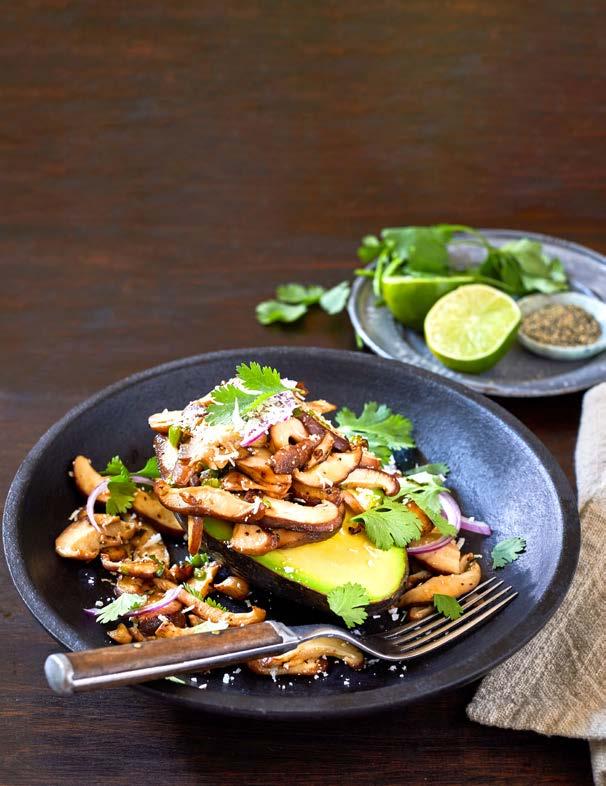
Recipe and photos by Pauline Stevens Serves 4
1 jalapeño pepper, chopped with seeds removed
¼ small red onion, chopped 1 c. of your favorite fresh mushrooms
1 T. olive oil
Salt and pepper
1 large avocado
Cilantro
Parmesan cheese
PREPARATION
Sauté peppers, onion and mushrooms in olive oil. Add salt and pepper to taste. Cut avocado in half and place on a plate. Leave it unpeeled to keep it in place. Top the avocado with mushrooms. Add cilantro and parmesan cheese to taste.
Beside her passion for photography, Pauline Stevens enjoys traveling and baking. She also visits every possible farmers market, even between frequent visits to NYC where her quadruplet sons live. Follow her store on IG @redbirdshouse.
edibleaustin.com 31
More Mourvèdre
WITH ITS BEAUTIFUL AND DYNAMIC EXPRESSION OF TEXAS TERROIR, MOURVÈDRE STANDS OUT AT WINERIES ACROSS THE STATE
WORDS BY STACEY INGRAM KALEH
Sw irling a glass of Mourvèdre, deep red with a tinge of indigo, emboldens aromas of violet, dark fruit and pepper. Complex and layered, a sip of this medium-bodied wine holds notes of berries and iron and piques the imagination. Pronounced “more-VEDD,” with almost no one articulating it precisely the same way, this gorgeous and dynamic varietal stands out here in Texas.
Some local winemakers call it “the soldier grape,” others are calling it the “Pinot of Texas.” What if Mourvèdre could stand on its own as the Mourvèdre of Texas?
I spoke with several Texas vintners as they prepared for harvest who emphasized this grape’s resilience to Texas’ weather extremes, its versatility in expressions, its pairings with the foods Texans love — especially barbeque — and its impressive ability to capture Texas’ unique terroir. Mourvèdre seems to be on track to become one of our state’s most reliable varietals, increasingly entwined with Texas’ identity in the wine market.
Mourvèdre is thought to be an ancient varietal, with roots in Valencia, Spain, where it is called “Monastrell” and could be found as long ago as 500 B.C.E. By at least the 16th century, it could be found in the Roussillon, Provence and Rhône regions of France where it became widely used in Grenache-Syrah-Mourvèdre (GMS) blends like Côtes du Rhône or Châteauneuf-du-Pape. The grape eventually made its way to Australia, where it’s called “Mataro,” to California in the 1860s and is now grown across the Texas Hill Country and High Plains.
Texas vineyards have been growing Mourvèdre since the early 2000s.
Chris Brundrett, co-founder and winemaker at William Chris Vineyards in Hye, was one of the early champions of the grape. “I had really fallen in love with some of the wines I was drinking from Spain and the southern part of France. I had done all of the research and was like, ‘This grape could be great for Texas, so I was kind of on this mission to get some of it planted in Texas. There were maybe two blocks in the state before then, but I wasn’t aware of them at the time.” Around 2006, Brundrett started conversations with Lost Draw Vineyard owner and operator Andy Timmons, who he considers a mentor. When Brundrett and Bill Blackmon established William Chris Vineyards in 2008, they planted their first block of Mourvèdre at Lost Draw. After the vines started producing fruit, the winery released the first Mourvèdre under the William Chris label in 2010.
“We call it the ‘soldier grape,’ because Mourvèdre… grows straight up,” says Brundrett. “And even in some of our most challenging years, Mourvèdre just loved the heat and it did fine through the freezes.”
Brundrett pinpoints several benefits to a varietal that is resilient to Texas weather. “Our goal is to grow and produce sustainably, and Mourvèdre helps achieve that goal,” says Brundrett. “It’s important to grow and make things that want to be here.” A bedrock of William Chris’s philosophy is a commitment to sustainable and regenerative practices.
“The fruit quality is just incredible,” says Brundrett. He appreciates the varietal for its consistent quality, which he views as a key aspect of sustainability.
“Sustainability is seeing great quality year-in and year-out or nine out of ten
years and being able to produce a high quality wine that is delicious and soulful and that people want to enjoy,” he says. What gives Mourvèdre an edge in Texas?
According to Brundrett, our state’s size can be an advantage.
“Texas is a huge state … It can be seen as a blessing and a curse, but I see it as more of a blessing. It creates a lot of opportunity for us to experiment with different varieties and learn about different varieties in different regions.”
He is enthusiastic about the community of wine producers in the Hill Country and hopes that more and more people will try Mourvèdre and come to enjoy it as much as he does. “I want to encourage your readers to look at some of the best producers and start there, and then not be afraid to wander off the beaten path and try some of the younger producers because so many of our neighbors are doing such a great job,” he says.
William Chris now produces Mourvèdre at its Hill Country Estate, at Lost Draw vineyards in the High Plains, and at other Texas vineyards. It offers at least six different Mourvèdres, available at the winery and online. Brundrett also travels to international wine conferences, choosing to pour Mourvèdre as a representation of Texas wine. “Very few places in the world can grow Mourvèdre like Texas grows Mourvèdre,” he states.
Salt Lick Cellars in Driftwood is another Texas vineyard that has deeply invested in Mourvèdre. It accounts for approximately a quarter of its 50-acre vineyard. Garrett Strickler, vineyard manager, has a background in horticulture and farming and has been with Salt Lick for eight years helping its vines to thrive. He shares Brundrett’s enthusiasm for the varietal, “I have a personal affinity bordering on the evangelical for Mourvèdre.” Strickler explains, “Mourvèdre is reliable. From a vineyard perspective, it’s so easy to manage compared to the other varieties. It’s late-budding so it misses most of the freeze damage and it really benefits from and enjoys our hotter climate. Some of these varieties might be described as ‘tolerating’ our drought, whereas Mourvèdre seems to thrive in it.”
Switching from vineyard manager to avid Texas-wine drinker, he adds, “It’s really rare to come across a winery or a tasting room where they say, ‘Yeah, you know our Mourvèdre is OK but it’s not really my favorite.’” Strickler shares that when he’s come across Mourvèdre in Texas tasting rooms, whether it is a rosé, a fruit-forward High Plains expression or a bold, oak-aged Hill Country expression, he feels it’s been consistently high quality. “I think it would be beneficial for us as a region to embrace a variety like Mourvèdre that is telling us over and over, ‘You can trust me,’” Strickler encourages, “Every year is a Mourvèdre year.”
While Salt Lick Cellars cares for extensive vineyards, it does not make wine onsite. It partners with neighboring Driftwood winemakers like Duchman Family Winery and Fall Creek Vineyards, and others, to produce the wines for Salt Lick Cellars. Those wines can be enjoyed at the Salt Lick Cellars tasting room, which is tucked under a shady oak grove next to the infamous barbeque restaurant.
Mourvèdre has traditionally been known as a great blending grape, and Salt Lick first planted the varietal for that purpose. Though it makes a GSM that features its Mourvèdre, Stickler says it stands out “as a single varietal.”
The 2018 Salt Lick Cellars Mourvèdre I tasted was a knock-out. It was both earthy and mouth-wateringly jammy with a hint of oak and a layered, lasting finish. “It’s a best-selling wine for us and 100 percent from our site,” Strickler tells me.
At Salt Lick Cellars, the wine showcases the vineyard’s limestone and nutrient-rich alluvial soil, a benefit being in the Onion Creek floodplain.
Another thing that makes this varietal a go-to for Strickler is its “broad spectrum of expression.” It can be used to make wines ranging from a light rosé to an elegant blend to a big, bold red. Stickler says more than 12 winemakers source their Mourvèdre fruit from Salt Lick’s vineyards, and that he enjoys all of the distinctive expressions that originated from the site.
Partnerships are a characteristic of the Texas Hill Country wine community.
One of the winemakers who sources Mourvèdre from the Salt Lick is Joshua Fritsche, owner/winemaker at Tatum Cellars. Fritsche started Tatum Cellars in 2012, the year his daughter, Tatum Rose, was born. He began making Provence-style rosé wines while working at William Chris, where he would sell it upon request without a tasting room or online presence.
As he built a cult following and expanded his wine portfolio, he opened a tasting room in the Johnson City town square this year.
Fritsche ages his Mourvèdre sur lie (This translates to “on the lees.” Lees are leftover yeast particles created by the fermentation process, which can add unique textures to the wine) in neutral oak barrels for 18–22 months. When you sip his wine, its reminiscent of Old World styles — earthy with notes of ripe plum, red meat and chalky herbs.
He’s more than a fan of Rhône varieties, and appreciates Mourvèdre’s resilience and versatility. “My experience with Mourvèdre from all across the state showed me that the grape does really well here,” says Fritsche. “It's late budding and cold hardy so it misses the late spring freezes. It just makes sense from a grower standpoint. It's very happy here.”
He sees a promising future for Mourvèdre in Texas. “This is a large state with vineyards spread all over and we're just starting to really focus on what varieties make sense in specific areas. Mourvèdre has proven itself to grow well pretty much anywhere here.”
In Houston, Decant Urban Winery is introducing its customers to Mourvèdre. In 2017, Winemaker Kristina Olivarez Tucker and her husband co-founded this city-based winery that produces wines in a warehouse using low-intervention techniques. They source their Mourvèdre from the Texas High Plains and age it in neutral French oak barrels to maximize the expression of the fruit and the vineyard. “Our Mourvèdre is lighter and brighter. It looks like cranberry juice in the glass,” says Olivarez Tucker. “You get the characteristic smoky, gamey/meatiness, and then a lot of tart raspberry, orange, and spice.”

She prefers to serve it chilled and with barbeque. “When it’s 105° and you want a red, it’s perfect,” she shares. “It goes really well with brisket, ribs and fajitas, and it’s high acid so it helps cut through any fat.”
What influenced Olivarez Tucker’s decision to make and serve Mourvèdre? “Well, it probably goes without saying but we try to make wines and varietals we like!”
Brundrett, Strickler, Fritsche and Olivarez Tucker all share a personal passion for the varietal. It’s a wine they love to drink themselves and that pairs well with the Texas foods they love, from barbacoa tacos to barbeque. Mourvèdre and Texas seem destined for each other.
WHERE TO ENJOY
If you haven’t yet ventured out for a glass of Texas Mourvèdre, there’s no better time to try it. And, if you’ve had it before, the range of expressions in the wine found at different Texas wineries leaves room for discovery and adventure. Mourvèdre’s medium-bodied complexity makes it enjoyable for porch-sipping throughout the fall. Be sure to ask for it in tasting rooms during Texas Wine Month this October and pick up a bottle to pair with your Thanksgiving dinner. Your friends and family will thank you!
Stacey Ingram Kaleh is a native Texan and writer and editor for Edible publications When she’s not eating at local restaurants and drinking Texas wine, she’s spending time outdoors in the Hill Country with her husband and two young daughters and soaking up as much live music and art as possible.
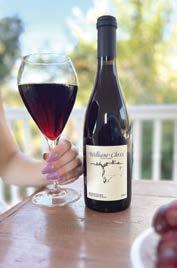
edibleaustin.com 33 32 Fall 2023
EDIBLE VARIETALS
Left Page: William Chris photo by Jerri Ann Yznaga
Right Page: Photo by Decant Urban Winery
Sip on a glass or pick up a bottle of Mourvèdre at these Texas Wineries and others:

Ab Astris
320 Klein Road Stonewall, TX 78671 abastriswinery.com
@abastriswinery
Augusta Vin 140 Augusta Vin Ln. Fredericksburg, TX 78624 augustavin.com
@augustavinwinery
Decant Urban Winery 948 Wakefield Dr. Houston, TX 77018 decantwinery.com
@decantwinery
Fall Creek Vineyards 1820 County Rd. 222 Tow, TX 78627 and 18059 FM 1826 Driftwood, TX 78619 Fcv.com
@fallcreekvineyards
French Connection Wines 1197 Hye-Albert Rd. Hye, TX 78635 frenchconnectionhye.com
@frenchconnectionwines
Hilmy Cellars 12346 E. US Hwy 290 Fredericksburg, TX 78624 hilmywine.com @hilmywine
Kuhlman Cellars 18421 E. US Hwy 290 Stonewall, TX 78671 visit.kuhlmancellars.com
@kuhlmancellars
Messina Hof Bryan Estate Winery 4545 Old Reliance Rd. Bryan, TX 77808
Harvest Green 8921 Harlem Rd. Richmond, TX 77406
Hill Country 9996 US Hwy. 290 Fredericksburg, TX 78624 messinahof.com
@messina_hof
Nice Winery 1220 Lumpkin Rd. Houston, TX 77043 nicewines.com
Pedernales Cellars 2916 Upper Albert Road Stonewall, TX 78671 pedernalescellars.com
@pedernalescellars
Perissos Vineyard and Winery 7214 Park Rd. 4 W. Burnet, TX 78611 perissosvineyards.org
@officialperissosvineyards
Salt Lick Cellars & Wine Garden 18300 FM 1826 Driftwood, TX 78619 saltlickcellars.com
@saltlickcellars
The Burg Wine Company Fredericksburg, TX theburg.wine
@theburgwineco
William Chris Vineyards 10352 US Hwy 290 Hye, TX 78635 williamchriswines.com
@williamchrisvineyards

34 Fall 2023
Buzzing Texas Honey Harvest is
WORDS BY ASHLEY BROWN | PHOTOS BY PAULINE STEVENS
Over the last decade or so, more and more Texans are going wild about bees and honey, and for good reason. It’s easy to quickly become fascinated by these creatures, their role in our ecosystem and, of course, the delicious and nutritious honey they provide.
There are about 20,000 different species of bees on the planet, with about 1,000 native to Texas. Bees are integral to our global ecosystem, pollinating fruits, crops, flowers and vegetables — in fact, about onethird of the food we eat. But the bee population has declined over the years due to climate change, pesticides and parasites, making it necessary for us to consciously support the bee population. One way to do that is to plant native bee-friendly plants and trees such as mesquite, vitex, crepe myrtles and Texas mountain laurels. Also, it’s a great help to provide a water source for wildlife and to avoid the use of chemicals on your lawn and garden. If you have to use pesticides or herbicides, it’s best to do it at night because bees usually don’t forage at night.

THE HIVE HIERARCHY
Honeybees live in colonies, also known as hives. According to Tanya Phillips of Texas Honey Bee Farm, a honeybee colony works like a family unit — each bee working to do what’s in the best interest of the colony as a whole. In any hive, there are three types of bees — with the most important being the queen bee, who lives about five years. All activity in a hive is centered around her and without her, everything falls apart. The queen goes on one mating trip during her lifetime, during which she mates with five to 45 drones (or male bees), and then stores a lifetime supply of sperm. Drones die after mating with the queen — this is their only purpose.
The third type of bee is the worker bees, all female, and they have different jobs based on their age. They forage, nurse baby bees, clean the hive, pollinate, use their vibrations to regulate the temperature of the hive for the queen and defend against predators. They communicate primarily through pheromones. Bees’ sense of smell is 50 times more powerful than that of dogs. Worker bees are the only ones with stingers. They can only sting once, as their stinger stays behind when they fly
away, pulling out their intestines. Living an average of six to eight weeks, a worker bee flies amazing distances during that short lifespan — visiting 50–100 flowers in every foraging trip. A single bee, however, will only produce about a half teaspoon of honey in its lifetime, but together, a hive can produce up to 100 pounds of honey annually.
HONEY: NATURE’S MIRACLE FOOD
Honeybees make honey by regurgitating digested nectar into honeycomb cells and then fanning it with their wings. They bring as much nectar as they can find into the hive. This typically allows them to save up more honey than they need, so beekeepers can remove some of the extra honey to eat and sell. This surplus, though, doesn’t exist in times of drought or cold temperatures.
The variety in color and flavor of honey — which is 80 percent sugar and 20 percent water — is determined by the flowers and plants from which the bees collect nectar. The darker the honey, the more antioxidants it has. “Not only is honey tasty but it should have its own spot in your household medicine cabinet,” says Sandi Murray of HIVE Bee Farm. She says honey is a great alternative to refined sugars due to its lower glycemic index, plus its beneficial enzymes can have positive health impacts.
“Honey is a great option for those looking to improve their environmental allergies. One spoon a day can have a big impact,” she says. Honey also has antibacterial properties and can be used to treat wounds.
A final fun fact about honey: it never goes bad. It was used in ancient Egypt for embalming, and thousands of years later, offerings left in tombs that were cured or embalmed with honey are still preserved.
BEEKEEPING



Despite a growing interest in bees, beekeeping (or apiculture) is not something one can just decide to do without some prior research or experience. To keep bees safe and happy requires a lot of knowledge, time and care. They need to be near a reliable water source, and hives should be inspected regularly. At times, bees may need to be fed to keep them from swarming (or leaving in search of food or water).
Most beekeepers will tell you that they learned early on that protective equipment is necessary to handle the hives — or that they had to accept getting stung. Bees are defensive and aggressive, driven by their desire to protect the queen. A sting or two may not be a big deal for some, but for those with allergies, even just a few stings can be fatal.
Ironically, bee venom actually has many healthful properties. For centuries, it’s been used as a remedy for inflammation, arthritis, skin disease, immunity problems and pain.


If you’re craving some honey or seeking inspiration to dive into beekeeping yourself, check out these local Texans who are passionate about supporting the bee population and serving up their syrupy, sweet goodness in jar.
DUNSMORE HONEY (NEW BRAUNFELS)
Dunsmore Honey is a family-owned small farm with a mission to raise healthy bees and produce raw honey. The family is driven by a love for nature, caring for the earth and a desire for homegrown, healthy food. Committed to improving the overall health of their environment, their farmland is dedicated to native Texas plants and wildlife. The bees that produce their honey are on their property, getting nourishment from the local pasture and forest land.
In 2014, Jason Dunsmore began beekeeping on their 12 acres in New Braunfels. He learned a lot — particularly about managing an apiary without chemical treatments and how to leave enough honey for the bees to eat themselves — from the local bee club, the San Marcos Bee Wranglers. Amy Dunsmore’s background is in environmental advocacy, animal behavior and ecology. The two met at The University of Texas Medical Branch, Galveston before attending graduate school together at University of California, Los Angeles. With the kitchen and garden as their current laboratories, the duo continues their scientific research, which nurtures their respect for the environment and guides their farming and honey-making methods.
“We minimally process the honey so that it contains every bit of pollen, antioxidants, vitamins, minerals, amino acids, enzymes, propolis and aromatics that bees collect from plants endemic to Edwards Plateau and the Blackland Prairie in the Balcones Canyonlands,” says Amy. This preserves the flavor and medicinal benefits of their raw honey. In addition to honey, they offer herbal elixirs, beeswax salves and balms, and honey blended with herbs and spices — all handmade at the farm. dunsmorehoney.com
TEXAS HONEY BEE FARM (AUSTIN)
“Our beekeeping journey started in the fall of 2012 when we took a beekeeping class at a local meadery. We were hooked!” says Tanya Phillips, master beekeeper and owner of Texas Honey Bee Farm. Phillips was particularly interested in the output from beehives that can be used for making skin care and health products. The current store, Texas Honey Bee Farm, opened in southwest Austin in 2019. The farm is home to up to 150 colonies that are for tours, classes, beeswax, pollen, honey and pollination of their garden and fruit tree They also have larger honeyproducing colonies around Southwest and East Austin.
“Honey is a perfect food,” says Phillips. “When you buy local wildflower honey, you are also getting a taste of the local pollen from the nearby flowers, which a lot of people say helps lessen their allergy symptoms. Besides honey, you can also buy a few other special things we, or the bees, make … like candles, raw beeswax, propolis tincture, raw pollen, lip balms, lotion bars, beeswax wraps and more.”
Texas Honey Bee Farm also offers educational opportunities, including beginning and hands-on beekeeping classes and occasional classes on honey harvesting and making products with beeswax. texashoneybeefarm.com

edibleaustin.com 37 36 Fall 2023
FARMERS DIARY
Left: Honey I'm Home photo by Rodney Bursiel
Right: Dunsmore Honey
Bottom Right: Tanya Philips photo by Ralph Yznaga
HONEY I'M HOME (WIMBERLEY)

Chris and Kayla Anderson are making their property in Wimberley a wildlife-friendly environment. They’re early in their beekeeping endeavor, with six hives (that’s still about 200,000 bees). After acquiring their bees, they noticed almost immediately how healthy the plants and trees on the property became and that an abundance of wildflowers began popping up. They point to a grove of crepe myrtles that are blossoming in midAugust after a summer of record-breaking heat and almost no rain. Those conditions haven’t made it easy to keep the bees healthy. The couple had to skip the summer harvest because the bees needed the honey to survive. If their bees remain healthy, they expect to harvest about 10 gallons of honey from their small number of hives. For them, packaging 100+ jars is for now more than enough to offer friends and family and to supply a local restaurant or two. Chris has enjoyed learning about bees and honey, including the relatively simple process of getting the honey from the hive to the jar. “You pull the frames and take a fork to break the wax that caps the honey,” he explains. “But first you inspect to make sure there are no babies, and certainly not the queen, on the frame! And then you put it in [a device that] is like an old-fashioned ice cream maker. You put the frames in, turn the crank, and the honey slides to the bottom. You open the spigot and pour it into the jar.”
HIVE BEE FARM (MONTGOMERY)



At the heart of the HIVE Bee Farm is Sandi Murray’s enjoyment of gardening and nature as well as her commitment to local, sustainable farming and food production. Before acquiring her first two hives in 2016, she did her homework. “It’s hard to really know what to expect and the commitment it takes until you’ve been around 60,000 stinging insects, in a bee suit, in 100+ degrees in the Texas summer,” says Murray. She recommends that anyone interested in beekeeping take a hands-on class, shadow an expert for a season and join their local beekeeping association. Her operation grew from two hives to over 200, spanning Montgomery, Harris and Fort Bend counties. Murray and partner Cyrus Nasr’s acreage in Montgomery is home to some of those hives as well as the workshop where they process the honeycomb and honey. The success of the different colonies is varied. “Each year is different and that variability in the weather, foraging opportunities and other pressures make it very challenging to predict what may impact the bees,” says Murray. “Unlike larger commercial bee companies that move bees across states to focus on specific commercial crops, our bees stay on a location permanently, enjoying the biodiversity of that environment.”
HIVE Bee Farm is committed to sustainable apiculture, which means they support hives that have a strong ability to adapt and forage effectively where they are. They do not provide supplemental feed or use any chemicals or antibiotics. Being in an urban environment, where properties are close to one another and chemical use is common, can make that challenging. “When a honey or native bee lands on a bloom that’s been sprayed, they take those chemicals back to their colonies with them and it can have disastrous effects — perhaps immediately killing the hive. And even cumulative exposure gradually impacts the health and genetics of the bees over time. As gardeners ourselves, I fully understand the reason behind reaching for the chemicals but know that those choices lead to long term challenges,” says Murray.
Murray finds beekeeping fascinating and rewarding, and she loves the honey! “Right now, we are big into using honey in our watermelon salad and in our homemade ice cream instead of sugar. Both are a great boost on these hot Texas days.”


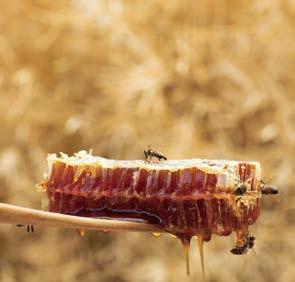
hivebeefarm.com

38 Fall 2023
Writer and editor Ashley Brown lives in Wimberley with her family of rescues: a dog, two cats, and two donkeys. In addition to animal welfare, her passion is exploring the Hill Country's natural beauty, small farms, eateries and drinkeries.
Dunsmore Honey Photos
Far Right: Texas Honey Bee Farm Hive with Queen photo by Ralph Yznaga











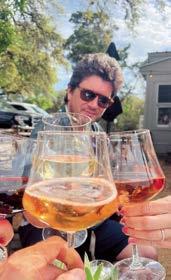

Discover the Hill Country in Every Sip –Ranch Brand Wine & Spirits: Where Flavor Meets Tradition. Visit Our Tasting Room in the Village of Wimberley Today for Unforgettable Tastes and Memories. Open 7 Days a Week! Join us in the village of Wimberley at 13619 Ranch Road 12, TX 78676. What we offer: • Premium Fine Wines • Artisanal Handcrafted Spirits • Full Cocktail Menu • Extensive Wine Tasting & Retail • Freshly Prepared Tapas • Kid-Friendly Mocktails Open 7 days a week, Ranch Brand is your destination for quality drinks and memorable moments. Visit us at www.ranchbrands.com or on social media @ranchbrandwineandspirits or email us at info@ranchbrands.com
















































 WORDS BY STACEY INGRAM KALEH | PHOTOS BY MOZART'S COFFEE ROASTERS
WORDS BY STACEY INGRAM KALEH | PHOTOS BY MOZART'S COFFEE ROASTERS













 WORDS AND PHOTOS BY CHRISTINA GARCIA
WORDS AND PHOTOS BY CHRISTINA GARCIA















 WORDS BY NATHAN MATTISE | PHOTOS BY RALPH YZNAGA
WORDS BY NATHAN MATTISE | PHOTOS BY RALPH YZNAGA











































































